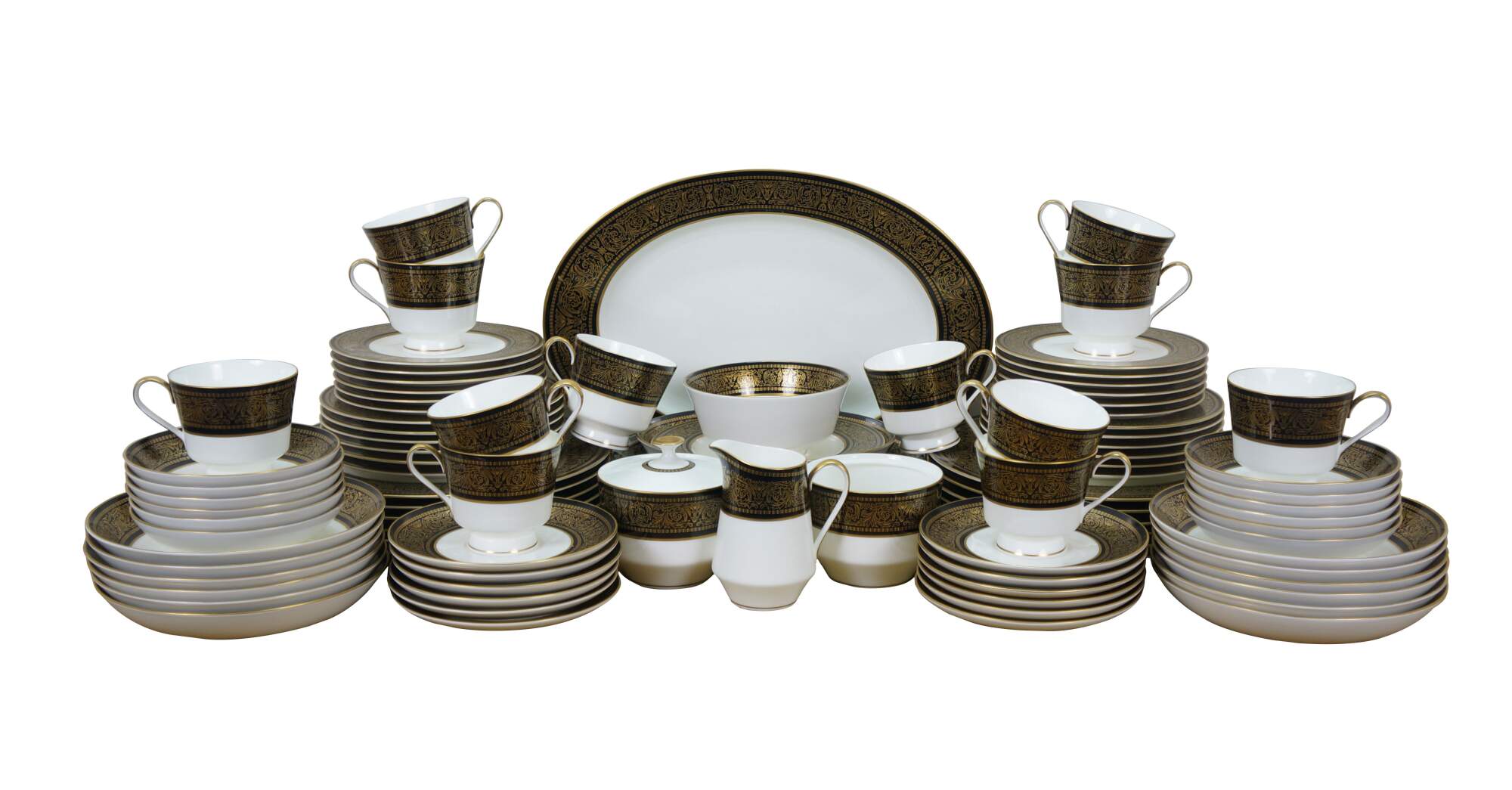
Shipping:
Free Shipping Included
Delivery:
Estimated 2-15 Business Days
Payments:
Credit Card, Check, Cash, PayPal, Apple Pay, Venmo
Returns:
30 Days 100% Money Back Guarantee, Buyer Pays Return Shipping
Description
Circa late 20th century 92 piece set of Mikasa Narumi - Japan Bone China in the Mount Holyoke 114 pattern. White porcelain with black borders accented with gilt foliate designs. Includes service for 12 plus serving pieces: Oval Serving Platter, Oval Serving Dish, Round Serving Dish, Footed Serving Dish, 12 Dinner Plates, 12 Salad Plates, 12 Bread Plates, 2 Sugar Bowls (One Lid), Creamer, 12 Soup Bowls, 12 Custard Dishes, 12 Saucers, 12 Teacups.
"Mikasa’s predecessor was a company named All Star Trading, founded in 1936. The ties that connected All Star Trading and Mikasa were familial—the business legacy of the Aratani family. Setsuo Aratani, a Japanese-American, started All Star Trading as an import-export enterprise specializing in trade with Japan. When hostilities between Aratani’s source country and his supply country erupted on December 7, 1941, the business abruptly closed, but following World War II, Setsuo’s son George and a partner named Alfred Funabashi revived the trading company. The younger Aratani and Funabashi sold flash-frozen tuna and developed the company into one of the largest importers of toys, distributing its merchandise through a half-dozen department store chains on the East Coast. George Aratani founded Mikasa as "American Commercial Inc." in the state of California in 1948. Before the end of the 1950s, the pair began concentrating on importing china made in Japan, using the trademark they adopted in 1957—“Mikasa,” Japanese for “three umbrellas.” The gradual move into the chinaware business evolved into the company’s exclusive occupation by the early 1960s. In 1965, the company’s path crossed with a young department store merchandiser named Alfred Blake, who was impressed by the Mikasa designs he saw while working with Hudson’s Bay stores in Canada. Blake’s interest was sufficient to prompt a career move. He joined Mikasa as a commissioned sales representative for western Canada in 1965, when the California-based company was collecting $5 million a year in sales. Blake’s esteem for Mikasa’s merchandise translated into high sales, fueling his promotion within the company’s sales ranks. When Alfred Funabashi died in 1976, the impressive Blake was named president and began working alongside George Aratani. Under Blake’s operational control, Mikasa flowered into a vibrant enterprise. He made wholesale changes with alacrity. Blake broadened the company’s line of merchandise, adding crystal stemware and new, less expensive brands to buttress the company’s flagship Mikasa brand. Under Blake’s operational control, Mikasa flowered into a vibrant enterprise. He made wholesale changes with alacrity. Blake broadened the company’s line of merchandise, adding crystal stemware and new, less expensive brands to buttress the company’s flagship Mikasa brand. By the mid-1980s, confidence at the company’s headquarters was running high. Blake and a group of senior executives, who each held small investment stakes in the company, were ready to significantly increase their financial investment in the company. In 1985, the management group initiated a leveraged buyout (LBO) of the company, offering $1 million in cash and borrowing $31 million to obtain ownership from George Aratani. The LBO, completed in 1985, was a sign of the executives’ faith in Mikasa’s future, but to their chagrin, outside influences conspired against the new owners shortly after the deal was concluded. In 1986, Japan’s currency began to appreciate quickly against the U.S. dollar, making goods produced in Japan more expensive in the United States. To make matters worse, U.S. department stores were struggling with their own ills, forcing some retailers to close stores and others either to consolidate or to streamline their operations. Although the company did not escape the 1980s without experiencing several difficult years, strident growth arrived as the 1990s began, thanks in large part to the measures taken by Blake. His response to the growing strength of Japanese currency was crucial to the company’s trend-bucking success. Blake moved some of Mikasa’s production out of Japan to low-cost, contract operations in Malaysia, Thailand, and Yugoslavia, essentially doing what Nike did during the early 1980s to record prolific growth in a lackluster industry. While other chinamakers struggled to make money in the face of rising labor and operating costs incurred from their own factories, Mikasa thrived mainly because it owned no factories. The company contracted its designs to other manufacturers and prospered, while many of its competitors were held in check by escalating overhead. The cost-savings realized from outsourcing production also gave Mikasa another important advantage, namely, flexibility. The company could quickly increase production volume on popular patterns and quickly abandon designs that failed to impress customers. Additionally, enhanced flexibility in production enabled Mikasa to churn out a greater diversity of patterns than many of its competitors. With a larger number of designs introduced into the market each year, the company’s odds for success increased, frequently putting Mikasa on the leading edge of emerging trends. Blake also began to emphasize the expansion of the company’s outlet stores, which reduced the reliance on department stores and strengthened Mikasa’s brand identity. Mikasa is the result of the typical American success story and has plans to continue the growth of its retail division throughout the United States in the years to come." (Mikasa / Encyclopedia)
Condition
Good Overall - Light wear commensurate with use
Dimensions
Serving Platter - 15" x 10.75" x 1" / Teacup - 3.5" x 3" (Width x Depth x Height)